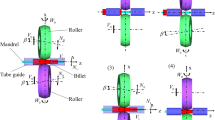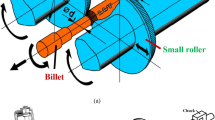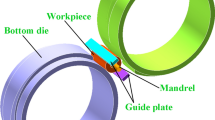Abstract
With the rapid development of high-end equipment in aviation, high-speed rail, and other fields, the requirements for the necessary shaft foundation parts on the equipment are more stringent. This has resulted in rapid development of the new generation of three-roll skew rolling (TRSR) flexible forming shaft part technology. It is an important issue to explore the theory and technology of TRSR flexible forming of hollow shaft and systematically expounding the flexible forming theory of TRSR of hollow axle. Therefore, this paper explores the feasibility of TRSR through the combination of theory and experiment and analyzes the formation mechanism as well as develop macro and micro uniformity law in order to clarify the quality control measures. In order to realize the low-cost forming of hollow axle with short process, the piercing-rolling compound forming (integrated forming of shape and inner hole of hollow axle) and the multi-roll skew tandem rolling technology for large section shrinkage shafts are innovated. The forming mechanism is verified through the simulation research. Based on the abovementioned research, it is concluded that skew-rolling composite integrated forming of large hollow shafts, multi-roll skew tandem rolling technology for large section shrinkage shafts, and the flexible forming process and equipment of digital TRSR is the future development direction of the TRSR flexible forming technology of hollow shaft. The results provide a theoretical basis and development direction for improving the precision short process, high efficiency, and high-quality manufacturing of high-end equipment shaft foundation.





























Similar content being viewed by others
Availability of data and material
The authors confirm that the data supporting the findings of this study are available within the article.
Code availability
Not applicable.
References
Yang C, Lu X, Sun Y, Zhuang X, Wang L (2018) Research status on forming technology for hollow shaft. Forging Stamp Technol 43(1):1–8 (In Chinese)
Chen E, Yang Y, Wang M, Du F (2008) Compare and analysis of the forming process of hollow part with mandrel and without mandrel by 3-roll cross wedge rolling. J Plast Eng 15(4):81–85 (In Chinese)
Xu C, Shu X, Zhu Y (2018) Simulation and analysis of three-roll skew rolling forming of the railway hollow shaft. J Ningbo Univ (Natural Science & Engineering Edition) 31(4):16–19. (In Chinese)
Huo Y, Bai Q, Wang B (2015) A new application of unified constitutive equations for cross wedge rolling of a high-speed railway axle steel. J Mater Process Technol 223:274–283
Li J (2007) Simulation study on radial forging process of hollow axle for high speed railway [dissertation]. Taiyuan Univ Sci Technol Taiyuan (In Chinese)
Zheng S (2018) Theoretical and experimental study on the shape control of multi wedge synchronous rolling of hollow train shaft [dissertation]. Ningbo University, Ningbo (In Chinese)
Wang L, Sun B, Peng W, Shu X (2015) Research on numerical simulation of three-roll screw rolling process for titanium alloy bars. Hot Working Tech 44(1):116–119 (In Chinese)
Л·M·Шкoльник, Zhang X (1985) Manufacturing of vehicle axles structure and process. Locomotive Rolling Stock Tech 5:1–5 (In Chinese)
B. B HOBИКOB, Gao L (2003) Axle weight 25t hollow axle. Foreign Rolling Stock 04:39–41
Xu C (2019) Feasibility study on hollow axle forming of three roll cross rolling high speed train [dissertation]. Ningbo University, Ningbo (In Chinese)
Shuai Z (2016) Numerical simulation and microstructure study of TC4 titanium alloy bar cross rolling [dissertation]. Taiyuan Univ Sci Technol Taiyuan (In Chinese)
Shuai Z, Hu J, Wen S, Liu Q (2016) Numerical simulation of three-roll screw rolling titanium alloy bar forming. Hot Working Tech 45(9):108–112 (In Chinese)
Mróz S, Szota P, Stefanik A (2016) The theoretical and experimental analysis of the possibility of employing the groove rolling process for the manufacture of Mg/Al bimetallic bars. Metalurgija 55(4):628–630
Gryc A, Bajor T (2016) The analysis of influence the parameters of rolling process in three high skew rolling mill of AZ31 magnesium alloy bars on temperature distribution. Metalurgija 55(4):771–774
Pater Z, Tomczak J, Bulzak T (2015) Numerical analysis of the skew rolling process for main shafts. Metallurgy 54(4):627–630
Pater Z, Bulzak T, Tomczak J (2016) Numerical analysis of a skew rolling process for producing a stepped hollow shaft made of Titanium Alloy Ti6Al4V. Arch Metal Mat 61(2):677–682
Pater Z (2017) FEM analysis of loads and torque in a skew rolling process for producing axisymmetric parts. Arch Metal and Mat 62(1):85–90
Pater Z, Tomczak J, Lis K, Bulzak T, Shu X (2020) Forming of rail car axles in a CNC skew rolling mill. Arch Civil and Mech Eng 20(3)
Tomczak J, Pater Z, Bulzak T, Lis K, Kusiak T, Sumorek A, Buczaj M (2021) Design and technological capabilities of a CNC skew rolling mill. Arch Civil and Mech Eng 21(2):1–17
Wang J (2020) Study on microstructure uniformity of three roll cross rolling hollow axle [dissertation]. Ningbo University, Ningbo (In Chinese)
Zhang S, Shu X, Wang J, Xu C (2020) Deformation behavior of hollow axles with constant hole diameter by three-roll skew rolling. IMECE2020: Int Mech Eng Congress Exposition; virtual online
Zhang S, Shu X, Xu C, Wang J, Xia Y (2020) Simulation and experiment of reduction of equal-diameter hollow shafts with three-roll skew rolling. Procedia Manuf 50:183–186
Xu C, Ren G, Yuan X, Liu G, Sheng Z, Jiang Z (2008) The research on the process of flexible rolling for shaft forgings and experiment. J Plast Eng 15(2):5
Shu X, Zhang S, Ehmann K, Li Z, Wei Y (2020) Forming and uniformity of shaft parts without a stub bar by axial closed-open-type cross-wedge rolling. J Iron Steel Res Int 27(9):1054–1063
Zhang S, Shu X, Xia Y, Wang J (2021) Formation mechanism and control of the spiral marks of three-roll skew-rolled hollow axles. Metalurgija 60(1–2):51–54
Wang T, Qi K (2016) Metal plasticity - rolling theory and technology. Metallurgical Industry Press, Beijing (In Chinese)
Hwang Y, Tsai W, Tsai F, Her I (2006) Analytical and experimental study on the spiral marks of the rolled product during three-roll planetary rolling processes. Int J Machine Tools & Manuf 46(12–13):1555–1562
Zhang S, Deng L, Che L (2022) An integrated model of rolling force for extra-thick plate by combining theoretical model and neural network model. J Manuf Process 75:100–109
Zhang S, Deng L, Tian W, Che L, Li Y (2022) Deduction of a quadratic velocity field and its application to rolling force of extra-thick plate. Comput Math Appl 109:58–73
Zhang S, Shu X, Wang J, Ye C (2021) Formation and control of defects on the surface of hollow axles by three-roll skew rolling. IMECE2021: Int Mech Eng Congress Exposition; virtual online
Zhang S, Shu X, Xu C, Wang J, Li Z (2019) Research on wall thickness uniformity of hollow axles by three-roll skew rolling. IMECE2019: Int Mech Eng Congress Exposition; Salt Lake City, USA
Shu C, Zhang S, Bidare P, Essa K, Abdel-Wahab A, Shu X, Pater Z, Bartnicki J (2022) Microstructure evolution of three-roll skew-rolling formed hollow axles with uniform wall thickness. Int J Adv Manuf Technol 121:4069–4085
Wang J, Shu X, Zhang S (2020) Effect of process parameters on average grain size and microscopic uniformity of the three-roll skew rolling forming of the railway hollow shaft. Metalurgija 59(1):47–50
Wang J, Shu X, Zhang S, Li S, Zbigniew P, Xia Y, Jaroslaw B (2022) Research on microstructure evolution of the three-roll skew rolling hollow axle. Int J Adv Manuf Technol 118:837–847
Ye C, Shu X, Xia Y, Wang J, Zhang S (2022) Mechanism of integrated forming of shape and inner hole of hollow axle. Metalurgija 61(1):167–170
Funding
This study was funded by the National Natural Science Foundation of China (grant number: 51975301), the Natural Science Foundation of Zhejiang, China (grant number: LZ22E050002), and the Major Project of Science and Technology Innovation 2025 in Ningbo City, China (grant number: 2022Z064).
Author information
Authors and Affiliations
Contributions
Shu Xuedao made the experimental plans, performed data processing, and performed finite element simulations. Zhang Song and Shu Chang wrote the paper. Shu Xuedao and Zhang Song determined the direction of the paper and the purpose of the experiment. Wang Jitai, Ye Caoqi, and Xia Yingxiang assisted to complete the experiment and helped revise the paper. Essa Khamis and Pater Zbigniew assisted to complete the experiment and check the literature. All authors read and approved the final manuscript.
Corresponding author
Ethics declarations
Ethics approval
This work does not include human and animal; hence, ethical approval from any committee is not required.
Consent to participate
This work does not include human and animal; hence, consent to participate in the research is not required.
Consent for publication
The authors give the publisher the consent to publish the work.
Conflict of interest
The authors declare no competing interests.
Additional information
Publisher's Note
Springer Nature remains neutral with regard to jurisdictional claims in published maps and institutional affiliations.
Rights and permissions
Springer Nature or its licensor holds exclusive rights to this article under a publishing agreement with the author(s) or other rightsholder(s); author self-archiving of the accepted manuscript version of this article is solely governed by the terms of such publishing agreement and applicable law.
About this article
Cite this article
Shu, X., Zhang, S., Shu, C. et al. Research and prospect of flexible forming theory and technology of hollow shaft by three-roll skew rolling. Int J Adv Manuf Technol 123, 689–707 (2022). https://doi.org/10.1007/s00170-022-10242-y
Received:
Accepted:
Published:
Issue Date:
DOI: https://doi.org/10.1007/s00170-022-10242-y




